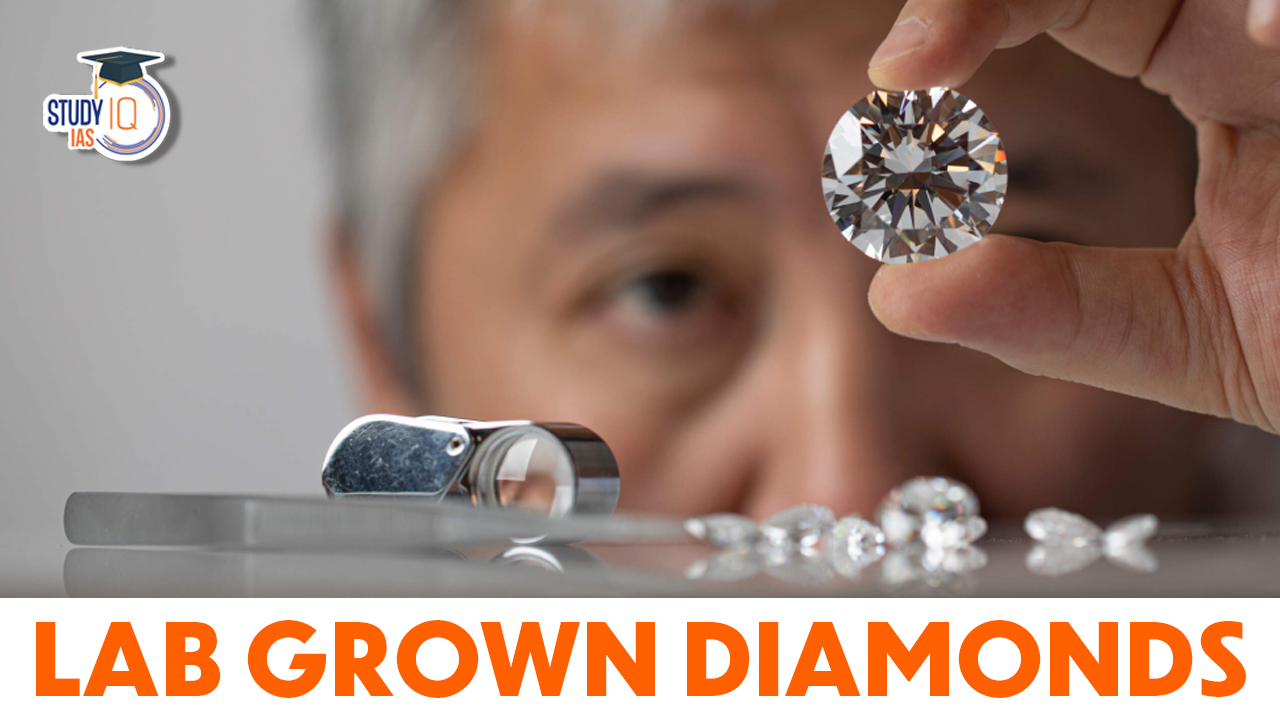Table of Contents
Context: Prime Minister Narendra Modi presented an exquisite gift to US First Lady Jill Biden – a lab-grown 7.5-carat green diamond – on his state visit to the United States.
What are Lab-Grown Diamonds (LGDs)?
- LGDs, also known as synthetic diamonds or cultured diamonds, are diamonds that are created in a laboratory environment rather than being formed naturally deep within the Earth’s crust.
- The world’s first-ever LGD was created in 1954 by scientists working at a General Electric research laboratory in New York.
- These diamonds have the same chemical composition, crystal structure, and physical properties as natural diamonds.
- However, LDGs are different from diamond simulants, which are materials that resemble the appearance of diamonds but have different chemical compositions and physical properties.
- Unlike lab-grown diamonds, simulants do not contain carbon atoms arranged in a crystal lattice structure like natural or synthetic diamonds.
- Examples of diamond stimulants include Moissanite, Cubic Zirconia (CZ), White Sapphire, YAG, etc.
How LDGs are Produced?
Lab-grown diamonds are produced by two primary methods:
- High-Pressure High-Temperature (HPHT):
- This method involves placing a small diamond seed in a chamber and applying high pressure and temperature to simulate the natural conditions under which diamonds form in the Earth’s mantle.
- Diamond seeds are small pieces of natural or synthetic diamond material that serve as the foundation for the growth of larger diamonds in a laboratory setting.
- Usually, graphite is used as the “diamond seed” and when subjected to these extreme conditions.
- Carbon atoms from a carbon-rich source are then dissolved and crystallize around the seed, gradually growing into a larger diamond.
- This method involves placing a small diamond seed in a chamber and applying high pressure and temperature to simulate the natural conditions under which diamonds form in the Earth’s mantle.
- Chemical Vapor Deposition (CVD):
- In this method, a diamond seed is placed in a chamber filled with carbon-rich gases.
- These gases are then ionized, breaking down the molecular bonds and causing carbon atoms to separate and deposit onto the diamond seed, layer by layer.
- Over time, the layers build up, resulting in the growth of a complete diamond.
Characteristics and Applications of LDGs
- LGDs have basic properties similar to natural diamonds, including their optical dispersion, which provides them with the signature diamond sheen.
- However, since they are created in controlled environments, many of their properties can be enhanced for various purposes.
- LGDs are most often used for industrial purposes, in machines and tools.
- Their hardness and extra strength make them ideal for use as cutters.
- Pure synthetic diamonds have high thermal conductivity, but negligible electrical conductivity.
- This combination is invaluable for electronics where such diamonds can be used as a heat spreader for high-power laser diodes, laser arrays and high-power transistors.
Advantages of LDGs
- Declining natural reserves: As the Earth’s reserves of natural diamonds are getting depleted, LGDs are slowly replacing the prized gemstone in the jewellery industry.
- Low environmental footprint: The environmental footprint of a diamond grown in a laboratory is much lesser than that of a naturally occurring diamond.
- Lower energy consumption: It takes ten times more energy to extract a natural diamond (by open pit mining) from the earth than it takes in creating one above the ground.
- Similar features: Just like natural diamonds, since LGDs also undergo similar processes of polishing and cutting, they have a similar lustre. Furthermore, lab-grown diamonds are indistinguishable from natural diamonds to the naked eye and even to many gemological tests.
Union Budget 2023-24’s Push for LDGs
- Reducing custom duties: The 2023 Union Budget promises to reduce the basic customs duty on seeds used in the manufacture of lab-grown diamonds in a bid to popularize their production in India— the duty on seeds for rough LGDs will be reduced from 5% to nil.
- Research grant: A five-year research grant will also be provided to one of the Indian Institute of Technologies (IITs) for research and development in the field of LGDs.
- New tariff lines: A proposal for the creation of new tariff lines to help in better identification of a number of products, including synthetic diamonds has also been made.


 Daily Quiz 11 July 2025
Daily Quiz 11 July 2025
 Operation Baam: Baloch Separatist Group ...
Operation Baam: Baloch Separatist Group ...
 Article 326 and Electoral Roll Revision ...
Article 326 and Electoral Roll Revision ...





















